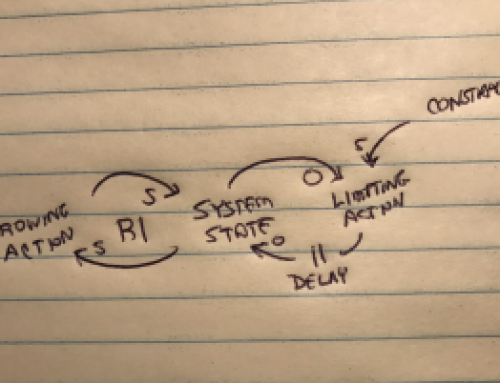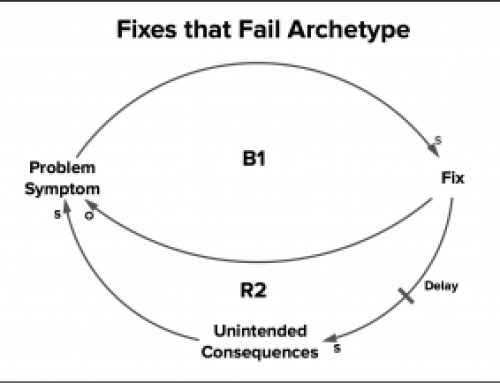I have been working through a series of articles focused on the change force within an organization that I labeled “Accepted Information & Routines.” This very significant change force within the learning organization framework is all about gathering and interpreting information, learning as you challenge that information and apply holistic, organic, systems thinking, and then interpret that information into knowledge, understanding, and actions based on that understanding and hopefully, wisdom that emerges from this process. This is truly the heart of the learning organization. Feel free to look back on the recent blog posts found on the site starting with “Change Forces & The Learning Organization” through the most recent posts if you need to catch up on this topic.
This post is the last in a series that is addressing only the first segment of this overall change force – gathering the RIGHT information. If you are going to turn information into action through learning, starting with the RIGHT information is a necessity and the folly of lacking information or having the wrong information is quite apparent. The first two methods of gathering information were (a) searching for information, and (b) asking the right questions to the right people (inquiring). The last method that I want to discuss in this post relates to acquiring information through the act of observation.
Learning to Make Time to Observe
As the wise Yogi Berra once said, “You can observe a lot by just watching.” There is also the most famous TV reality show about observing, “The Undercover Boss,” which takes this to an extreme and, of course, clearly demonstrates the power of observation. You might find that a little extreme in terms of deception, but you can’t deny the kind of truth that emerges. It is also doubtful that any of you are going to embark on this type of journey of observation within your own company. At the same time, observing is not necessarily something you make a priority and when you do, you don’t always observe. What am I getting at?
The first is straightforward. You are busy making decisions, leading or participating in meetings, talking on the phone, examining all the information that comes your way, and of hopefully, asking great questions and listening to the answers. It is likely that you do not stop, even informally, just to observe, and even more likely that you do not personally schedule, or ensure that other leaders schedule, specific observation opportunities. Why is this important? The fact is that the processing of searching for information and the process of asking questions is still going to fall short in uncovering certain types of information that may be vital to gaining the real wisdom required to commit to the right actions going forward. Some types of information such as latent attitudes towards specific tasks and processes, unmet needs, “workarounds” which have grown out of poorly executed systems or processes, tasks or processes that are skipped or avoided due to time constraints or lack of training, or those “accepted” routines that have become the norm. Any or all of these things may simply stay hidden even during a rigorous search for information or when asking questions.
So, the first crucial step is to commit to some form of observation, both in terms of informal moments when you just step back and commit to watching and listening, and perhaps a more formal commitment in terms of coaching leaders or even creating a specific work group that has this task. What might this look like?
Informal Observation
You may be thinking you do this. You may be right. However, I want to challenge you to reflect on whether you really flip a switch in our head in any given moment and say, “I am going to sit back and observe right now,” or whether you may just believe that you do absorb some observation in the course of conversations or meetings. It is very important that you recognize opportunities to intentionally switch into an observation mode. This would mean that you purposefully say very little, purposefully observe the body language of others in the situation, purposefully tune into the tone of voice or emotional undercurrent being expresses, and purposefully listen not just to the words being spoken but the thoughts and ideas that others are trying to verbalize.
Intentional observation can easily be done in a meeting. What about informal observation by “walking around.” Many CEOs talk about “management by walking around,” meaning that they believe there is value in impromptu encounters with individuals in the hallways of offices, or in the lunch room, or even through ducking into an office for a quick conversation. All of that is useless if the leader that is walking around does all the talking and does not draw out others for the purpose of hearing and observing.
Coaching for Observation
A second step you may want to consider is integrating a process to coach the importance of observation and skills of observation to leaders into your overall management-training program. Given that many leaders are generally the classic “A” type personality, busy, are likely used to talking a lot in meetings, and perhaps lack good active listening skills, creating specific training materials and coaching to the task of observing will generally yield positive results both in terms of the information you gain from observation and from furthering a more healthy culture that demonstrates to employees that you want to be connected to what is really going on.
Creating a Specific Work Group to Observe
In certain types of companies, you as a leader may discover that creating a specific work group for the purpose of “observing” may be essential to the health of your organization. For example, companies that create consumer products frequently have specific customer satisfaction departments that not only seek out information through search and inquiry related to how customers use and like or dislike their products, but may go even further and actually observe how consumers use their products. Certain products may stagnate or fall short of the competition unless you ensure that your product teams truly know how the product is installed, or used, or not used. This is vital information that may simply not surface when only asking questions.
With the significant rise in the use of websites by customers of all kinds, another form of observation may take a completely different form than that of human observation. You may want to dedicate funds and resources to truly “observe” (aka. “track”) how people truly use your website. You can certainly conduct a usability study and observe people in real-time using your website, but with today’s new technologies, you can also develop excellent electronic tracking of how people move through your website – their first page, their path through the site, their time on the site, their exit page, how they were referred to your site, etc. This is a new form of observation that others might call “search” since it gathers data, but it is truly more of an observation window that is extremely powerful and should not be left to struggle from a lack of funding, lack of expertise, or lack of commitment.
Learning to Actually Observe
In my introduction to this topic, I also stated that unfortunately, even when you may intend to observe, you don’t always actually, well, observe. A great example of this is for some organizations is the practice of the “sales call ride-along” where the sales manager accompanies an outside sales person on in-person sales calls. The purpose of this practice is understood as a process whereby the sales manager can observe the sales person in action. In reality, for many organizations, this practice is done as (a) a means for the sales manager to “close” a sales, (b) a means to “open doors” using the sales manager’s title when doors remain closed, or (c) an existing practice that has just been done over and over again and expected. Even more significantly, in many situations where the sales manager is present, the sales manager ends up doing all the talking and taking the lead, and thus, truly negates any true opportunity to observe what that sales person might be doing when that sales manager is not around.
The point is, once you decide that you want to observe and want others to observe more in your organization, make sure you teach people how to observe. I brought attention to a few of these key points earlier, but here is the more complete list of key principles to follow when observing:
- Gain permission and access from those you are observing, and ensure you build a sense of trust regarding your purpose (if those you are observing are not going to trust, they will not behave or work naturally).
- Where possible, do not participate actively in the activity, but instead simply watch and listen, saving questions when possible, for later.
- Watch body language as others interact.
- Observe what systems or tools they use or do not use.
- Look for specific tools, technology, or processes that may be “workarounds” that have been created from lack of existing tools, technology, etc.
- Keep a detailed record of your observations, noting questions you might have as you go.
- Try very hard to not interject your own biases into the observations.
- Make sure you don’t just jump in at the moment and say “you should do this,” or “why don’t you do this?” – let things play out and then you can ask questions.
- Don’t miss observations because you are in your head already trying to solve problems, classify things, creating action plans, etc. – Just watch, listen, and take notes. There will be the right time for questions, plans, decisions, etc.
Summary
I hope this brief primer on the observation will be helpful in your quest to find the RIGHT information in your organization. Whether you simply start observing more frequently and with more discipline informally, or whether you take steps to coach others to observe or even invest in a department committed to observation, you will find value in any incremental observation you develop. For some types of vital information, there is simply no substitute for observation.

